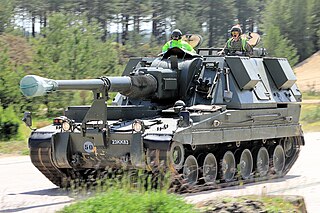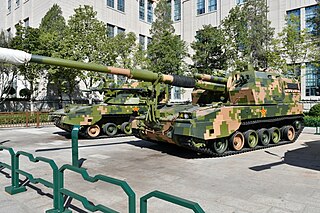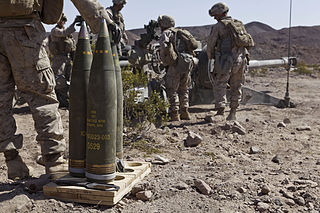
The M198 is a medium-sized, towed 155 mm artillery piece, developed for service with the United States Army and Marine Corps. It was commissioned to be a replacement for the World War II-era M114 155 mm howitzer. It was designed and prototyped at the Rock Island Arsenal in 1969 with firing tests beginning in 1970 and went into full production there in 1978. It entered service in 1979 and since then 1,600 units have been produced.

The M109 is an American 155 mm turreted self-propelled howitzer, first introduced in the early 1960s to replace the M44. It has been upgraded a number of times, most recently to the M109A7. The M109 family is the most common Western indirect-fire support weapon of maneuver brigades of armored and mechanized infantry divisions.

The 8 inch (203 mm) M110 self-propelled howitzer is an American self-propelled artillery system consisting of an M115 203 mm howitzer installed on a purpose-built chassis. Before its retirement from US service, it was the largest available self-propelled howitzer in the United States Army's inventory; it continues in service with the armed forces of other countries, to which it was exported. Missions include general support, counter-battery fire, and suppression of enemy air defense systems.

The AS-90, known officially as Gun Equipment 155 mm L131, is an armoured self-propelled artillery used by the British Army.

Nuclear artillery is a subset of limited-yield tactical nuclear weapons, in particular those weapons that are launched from the ground at battlefield targets. Nuclear artillery is commonly associated with shells delivered by a cannon, but in a technical sense short-range artillery rockets or tactical ballistic missiles are also included.

A mortar is usually a simple, lightweight, man-portable, muzzle-loaded weapon, consisting of a smooth-bore metal tube fixed to a base plate with a lightweight bipod mount and a sight. Mortars launch explosive shells in high-arching ballistic trajectories. Mortars are typically used as indirect fire weapons for close fire support with a variety of ammunition.

The FH70 is a towed howitzer used by several nations.

The M119 howitzer is a lightweight 105 mm howitzer, used by the United States Army. It is the American licensed version of the British L119 light gun. The M119 is typically towed by the M1097 or M1152 High Mobility Multi-Purpose Wheeled Vehicle (HMMWV), and can be easily airlifted by helicopter, or airdropped by parachute.

The Advanced Gun System (AGS) is a naval artillery system developed and produced by BAE Systems Armaments & Services for the Zumwalt-class destroyer of the United States Navy. Designated the 155 mm/62 (6.1-inch) Mark 51 Advanced Gun System (AGS), it was designed to provide long-range naval gunfire support against shore-based targets. A total of six of the systems were installed, two on each of the three Zumwalt-class ships. The Navy has no plans for additional Zumwalt-class ships, and no plans to deploy AGS on any other ship. AGS can only use ammunition designed specifically for the system. Only one ammunition type was designed, and the Navy halted its procurement in November 2016 due to cost, so the AGS has no ammunition and cannot be used. The Navy planned to remove the AGS from the ships starting in 2023.

The M982 Excalibur is a 155 mm extended-range guided artillery shell developed in a collaborative effort between the U.S. Army Research Laboratory (ARL) and the United States Army Armament Research, Development and Engineering Center (ARDEC). The Excalibur was developed and/or manufactured by prime contractor Raytheon Missiles & Defense, BAE Systems AB and other subs and primes in multiple capacities such as Camber Corporation and Huntington Ingalls Industries. It is a GPS and inertial-guided munition capable of being used in close support situations within 75–150 meters (250–490 ft) of friendly troops or in situations where targets might be prohibitively close to civilians to attack with conventional unguided artillery fire. In 2015, the United States planned to procure 7,474 rounds with a FY 2015 total program cost of US$1.9341 billion at an average cost of US$258,777 per unit. By 2016, unit costs were reduced to US$68,000 per round. Versions that add laser-guidance capability and are designed to be fired from naval guns began testing in 2015. By October 2018, over 1,400 rounds had been fired in combat.

The M-1978 Koksan, or officially Juchepo is a 170 mm self-propelled gun of North Korean design and manufacture. Very little information is available due to the secretive nature of the North Korean government. The designations M-1978 and Koksan were given to the type by US military analysts, as they first became aware of it in that year in Koksan, North Korea.

The 2S4 Tyulpan is a Soviet 240 mm self-propelled heavy mortar. "2S4" is its GRAU designation. The Tyulpan is the largest mortar system in use today.

The 2K25 Krasnopol is a Soviet 152/155 mm cannon-launched, fin-stabilized, base bleed-assisted, semi-automatic laser-guided artillery weapon system. It automatically 'homes' on a point illuminated by a laser designator, typically operated by a drone or ground-based artillery observer. Krasnopol projectiles are fired mainly from Soviet self-propelled howitzers such as the 2S3 Akatsiya and 2S19 Msta-S and are intended to engage small ground targets such as tanks, other direct fire weapons, strong-points, or other significant point targets visible to the observer. It can be used against both stationary and moving targets.

The 2A65 "Msta-B" is a Soviet towed 152.4 mm howitzer. The "B" in the designation is an abbreviation for Buksiruyemaya, which means towed. This weapon has been fielded in Soviet and Russian forces since at least 1987 and as of 2022 is currently in service with Russian front and army level artillery units, as well as the militaries of six other countries, most of them former Soviet republics.

The PLZ-05 or the Type 05 is a 155 mm self-propelled howitzer developed by the People's Liberation Army of China to replace the Type 59-1 130 mm towed gun and Type 83 152 mm self-propelled gun. The PLZ-05 was officially unveiled at the Military Museum of the Chinese People's Revolution to mark the 80th anniversary of the PLA in July 2007, and first entered service with the PLA in 2008.

155 mm is a NATO-standard artillery shell caliber that is used in many field guns, howitzers, and gun-howitzers. It is defined in AOP-29 part 1 with reference to STANAG 4425.

The M795 155 mm projectile is the US Army and US Marine Corps' standard 155 mm High Explosive (HE) projectile for howitzers. It is a bursting round with fragmentation and blast effects.

The M549 is a high-explosive rocket-assisted (HERA) 155 mm howitzer round developed for use by the US military in order to add additional range to standard howitzers, with a maximum range 30.1 km (18.7 mi) from a M198 howitzer. The projectile has two distinctive pre-assembled components—the high explosive (HE) warhead and the rocket motor, making it a form of rocket-assisted projectile. The warhead is fabricated from high fragmentation steel for increased effectiveness in terms of damage caused to target and contains a bulk-filled explosive.
The PLL-01, also known as the WAC-021, is a type of 155 mm howitzer designed by Gerald Bull and built by Chinese defense manufacturer Norinco.

The M1299 was an American prototype 155 mm self-propelled howitzer developed by BAE Systems beginning in 2019 under the Extended Range Cannon Artillery (ERCA) program. It was based on the M109A7 howitzer and was primarily designed for the purpose of improving the M109's effective range. The program was canceled in 2024.




















